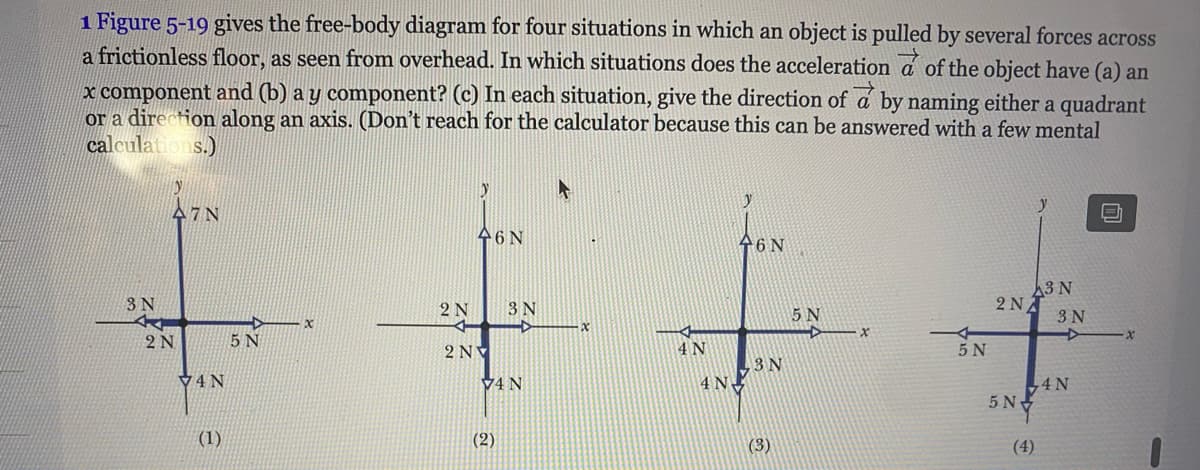1 Figure 5-19 gives the free-body diagram for four situations in which an object is pulled by several forces across a frictionless floor, as seen from overhead. In which situations does the acceleration a of the object have (a) an x component and (b) a y component? (c) In each situation, give the direction of a by naming either a quadrant or a direction along an axis. (Don't reach for the calculator because this can be answered with a few mental calculations.) A7N 46 N 46N 3 N 2NA 3 N 3 N 2 N 3 N 5 N 2N 5 N 2 NV 5 N 3 N 4 N V4 N V4 N 4 N 5 N (1) (2) (3) (4)
1 Figure 5-19 gives the free-body diagram for four situations in which an object is pulled by several forces across a frictionless floor, as seen from overhead. In which situations does the acceleration a of the object have (a) an x component and (b) a y component? (c) In each situation, give the direction of a by naming either a quadrant or a direction along an axis. (Don't reach for the calculator because this can be answered with a few mental calculations.) A7N 46 N 46N 3 N 2NA 3 N 3 N 2 N 3 N 5 N 2N 5 N 2 NV 5 N 3 N 4 N V4 N V4 N 4 N 5 N (1) (2) (3) (4)
Principles of Physics: A Calculus-Based Text
5th Edition
ISBN:9781133104261
Author:Raymond A. Serway, John W. Jewett
Publisher:Raymond A. Serway, John W. Jewett
Chapter5: More Applications Of Newton’s Laws
Section: Chapter Questions
Problem 12P: A block of mass 3.00 kg is pushed up against a wall by a force P that makes an angle of = 50.0 with...
Related questions
Topic Video
Question

Transcribed Image Text:1 Figure 5-19 gives the free-body diagram for four situations in which an object is pulled by several forces across
a frictionless floor, as seen from overhead. In which situations does the acceleration a of the object have (a) an
x component and (b) a y component? (c) In each situation, give the direction of a by naming either a quadrant
or a direction along an axis. (Don't reach for the calculator because this can be answered with a few mental
calculat
s.)
A7N
46N
46 N
3 N
3 N
2NT
3 N
2 N
3 N
5 N
2 N
5 N
2NV
4N
5 N
v4 N
,3N
4 N
,4N
5 N
V4 N
(1)
(2)
(3)
(4)
Expert Solution
This question has been solved!
Explore an expertly crafted, step-by-step solution for a thorough understanding of key concepts.
This is a popular solution!
Trending now
This is a popular solution!
Step by step
Solved in 2 steps with 2 images

Knowledge Booster
Learn more about
Need a deep-dive on the concept behind this application? Look no further. Learn more about this topic, physics and related others by exploring similar questions and additional content below.Recommended textbooks for you

Principles of Physics: A Calculus-Based Text
Physics
ISBN:
9781133104261
Author:
Raymond A. Serway, John W. Jewett
Publisher:
Cengage Learning

Physics for Scientists and Engineers with Modern …
Physics
ISBN:
9781337553292
Author:
Raymond A. Serway, John W. Jewett
Publisher:
Cengage Learning

Physics for Scientists and Engineers
Physics
ISBN:
9781337553278
Author:
Raymond A. Serway, John W. Jewett
Publisher:
Cengage Learning

Principles of Physics: A Calculus-Based Text
Physics
ISBN:
9781133104261
Author:
Raymond A. Serway, John W. Jewett
Publisher:
Cengage Learning

Physics for Scientists and Engineers with Modern …
Physics
ISBN:
9781337553292
Author:
Raymond A. Serway, John W. Jewett
Publisher:
Cengage Learning

Physics for Scientists and Engineers
Physics
ISBN:
9781337553278
Author:
Raymond A. Serway, John W. Jewett
Publisher:
Cengage Learning